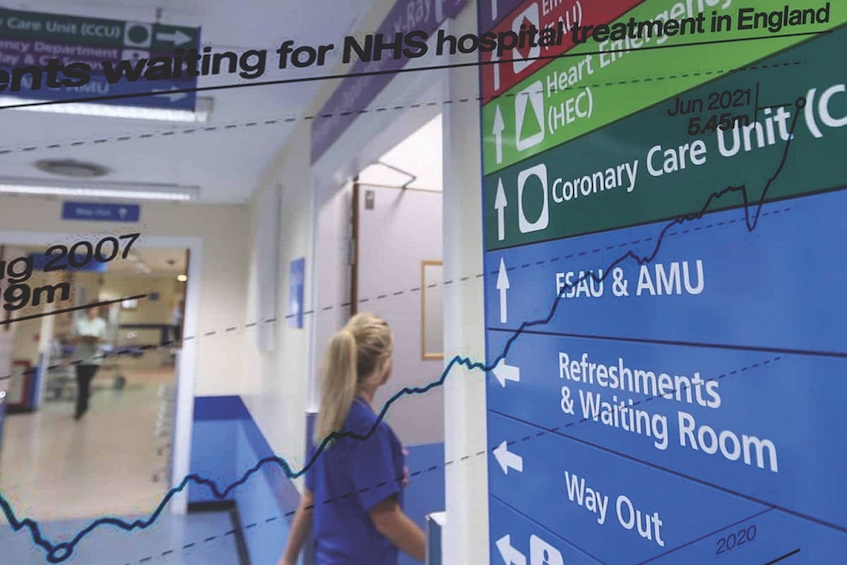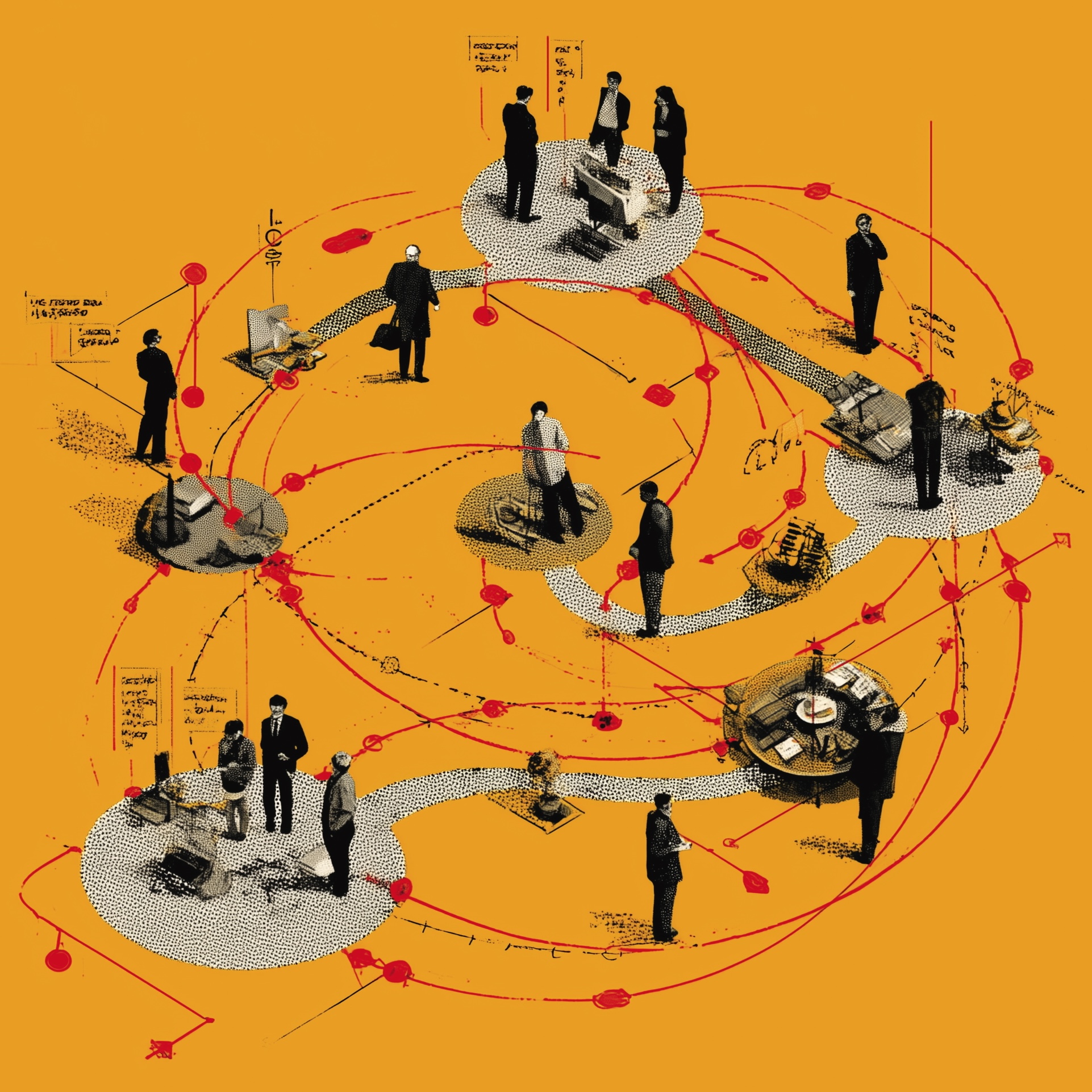Less for more, more for less or more or less the same?
The NHS is still struggling to recover from the pandemic, but studies show productivity was falling even before the Covid shock. We asked the experts: what’s driving this, does it matter and why are managers vital to turning productivity around?

“Quite a lot more money has gone into the NHS, we have more staff, particularly in hospitals, but as managers are well aware, everything feels worse,” says Rachel Wolf, founding partner at policy consultancy Public First. “Output is down across a whole range of measures, and yet people feel they’re scrambling and are working unbelievably hard.”
This is what Wolf calls “the productivity puzzle” – also the title of the fascinating report she co-authored with Sam Freedman from the Institute of Government . In recent months, the King’s Fund, the Health Foundation and the Institute for Fiscal Studies (IFS) have all joined the debate on post-Covid NHS performance. All concluded that the usual suspects – the pandemic, underfunding and staff shortages – don’t capture the whole story. The causes are complex, varied and not necessarily the ones politicians want to address.
“There’s no single thing that’s driving this and anyone who pretends otherwise is being disingenuous,” says Ben Zaranko, co-author of the IFS study NHS Funding, Resources and Treatment Volumes. “It helps to look at the pandemic as not just one difficult period we’re recovering from, but as a bigger shock to all sorts of different things. And we’re still figuring out what that means.”
More for less?
But first, what’s the evidence that NHS productivity is falling? All these studies show that, despite record vacancies, the NHS does indeed have more staff than before the pandemic, especially clinical staff in hospitals. And funding has risen too, although not by as much as promised. The IFS study shows average annual increases of 2.9% in real-terms NHS spending during this parliament, slightly below the level planned before the pandemic (3.4%) and the long-term average (3.6%).
There’s no single agreed measure of NHS output, and estimates are based on a range of indicators, both quantitative and qualitative (see box below). Taken together, there’s strong evidence that the NHS is struggling to return to pre-pandemic levels of output: waiting lists and the elective backlog remain stubbornly high and patient satisfaction is at a 40-year low. The IFS found that, with the notable exception of GP appointments and cancer referrals, activity in all categories of care was substantially lower than in 2019. Other studies came to similar conclusions.
The loaded bullet
So what exactly is going on? All the analysts we spoke to were clear that, while the pandemic was a major shock to the system, longer-running forces were at work. Productivity was already falling before Covid, and on some measures has been falling for a decade or more: the number of patients waiting per NHS worker has doubled since 2010. Wolf and Freedman’s report puts it starkly: “The trigger for the problems the NHS now faces may have been Covid, but the bullet had already been loaded beforehand.”
Crudely speaking, studies point the finger at three broad issues: a lack of capital investment in things like buildings, equipment and hospital beds; staffing problems including more sickness absence, high churn and the loss of experienced ‘productivity-critical’ staff; and a shortage of management capacity and problems with management systems. While impossible to quantify, the evidence points to each of these factors making a significant contribution to the productivity problem.
“There are long-running issues with continuing to hire more frontline clinical staff… while ignoring the equipment and buildings staff are working with, or the management systems that ensure they’re in the right place at the right time. Those things impede the ability of those staff to provide more care,” Zaranko explains. This doesn’t mean the NHS doesn’t need more doctors and nurses, he adds, just that the overall number of clinical staff is not the cause of the productivity problem.
Management matters
As a managers’ magazine, we naturally want to know where managers and management figure in all this. Do we have enough managers? Do they have the right capabilities? And do they have the power and autonomy to take the decisions that could boost NHS productivity?
At different points in The Productivity Puzzle, the NHS is described as “severely”, “chronically” and even “catastrophically” under-managed. That’s seems clear enough. “We don’t mean the number of people in NHS England or the department,” Wolf explains, “but people actually managing things in hospitals. They’re really quite small in number.” And clinician managers “do seem to make a difference”, she adds. “I’m not sure we’re good at persuading clinicians to become managers, or making it worthwhile for them.”
The NHS spends relatively little on management and administration by international standards and, like capital investment, management spending has not kept pace with growing clinical staff numbers. NHS workforce figures show 7% fewer managers now than in 2009, while clinical staffing has grown by 26% in the same period. Newspapers and politicians who constantly call for more doctors and nurses and fewer managers in the NHS have already got what they’re asking for.
“This notion that reducing managerial staff would somehow ‘free up’ front-line operations is not supported by the broader management literature,” says the IfG/Public First report, pointing to research showing a strong link between management capacity and both clinical and financial outcomes. “In other words, management matters,” the authors add.
The shortfall is particularly acute among the middle managers whose role in planning, co-ordinating and running local services is crucial to increasing productivity. “It does seem striking that we’ve added more money, we’ve added more staff, but the one thing that’s been cut back is that mid-level of management,” says Zaranko.
Skilled and empowered
But simply adding more managers is unlikely to be enough – capability and autonomy are just as important, and Wolf argues that, particularly since the Lansley reforms in 2013, NHS managers have less autonomy and less opportunity to increase productivity.
“The managers we have are really constrained in making decisions that could improve hospital productivity,” she says. Compared to the “enormous autonomy” enjoyed by schools, it’s “slightly strange”, she adds, that hospital managers have “so little freedom to take decisions”.
Bryan Jones, senior improvement fellow at the Health Foundation, says a lack of management capacity is likely to be a “significant factor” in the productivity problem. “Effective, capable management is fundamental to success in every field. If you don’t have managers on board, if they’re not skilled and empowered to think about today’s work and tomorrow’s work at the same time, I don’t think it’s possible to think about driving productivity improvement.” Some NHS organisations now “freely acknowledge that they haven’t thought about managers enough in this process,” he adds.
A 2021 Health Foundation paper identified five “drivers” of NHS productivity improvement: skill mix change, more patient involvement, improving patient flow, better use of technology and successful implementation. But researchers also pointed to an over-arching sixth factor, where managers play a vital role: organisational “agility”.
Agility refers to “your readiness for improvement, your readiness to do things differently”, Jones explains. “Whether you’re trying to create a more efficient, leaner health service, or improve quality, you need to have the right conditions in place.” Under-pressure organisations, “where people are focused only on the here and now, and don’t have the headspace to do things differently,” are unlikely to be conducive to change, he warns.
Freedom and frustration
What do our experts suggest the government and NHS leaders can do to help managers boost NHS productivity?
Jones recommends moving away from the “culture of compliance” which forces managers to focus on today’s targets rather than tomorrow’s needs. NHS England’s new IMPACT framework for improvement, with its emphasis on creating the right environment for improvement and empowering staff, is a “very encouraging” step, he says.
“But the challenge is sustaining it,” he warns. Successful organisations have “a consistent strategic constancy of purpose over ten or 15 years”. He points to Northumbria Healthcare as an example: “the board have had a very consistent message, they’ve invested heavily in listening to staff and patients and have a way of working which is now very embedded and has delivered a lot of success.”
He adds: “Leadership is so, so important because the NHS is still a very hierarchical system and it still looks very closely to what its leaders say and think and do.”
Wolf says politicians and NHS leaders “need to understand that the problem is not frontline staff numbers, but capital and management”. And she adds: “Personally, I think the NHS needs to return to something more akin to the incentive and control mix we had under the Blair/Brown governments…with fewer targets and more freedom for managers to take decisions on things like capital investment.”
While integration is “the right thing to do”, the way ICBs have been set up is a “total bureaucratic mess”, Wolf warns. “If one of our big findings is that managers need more control and autonomy, then having endless layers of accountability and organisations you have to report to doesn’t seem likely to make the situation better.”
But Zaranko sounds of note of caution. While the NHS is “incredibly centralised”, the experience of the pandemic, particularly the vaccine rollout and clinical trials, “showed some of the benefits of having a centralised system”, he says. By contrast, in Germany, “the system was seen as too disjointed” and there “was a lot of discontent about regional inequality” in the availability of vaccines and the management of the pandemic.
But Covid did “force more experimentation” and “encouraged people take on more responsibility”, Zaranko adds, “and the sky didn’t fall in”. New roles like nurse practitioners and physician assistants, and more flexible deployment of specialist staff like anaesthetists, have been “positive developments”, he says, as have the growth of advice and guidance services and the setting up of ‘hot and cold’ sites to “churn through” specific treatments. The pandemic also spurred improvements in waiting list management and the use of operating theatres.
But Wolf fears these benefits could be lost as central controls are reimposed. She recalls one conversation with a senior NHS manager who wanted to add capacity to their service. “They told me that the speed was so much faster and the cost so much lower during the pandemic. But then it all went back to normal and now it feels very frustrating again.”
There’s no magic bullet to solving the productivity puzzle. It will take investment and years of of hard work, much of it by managers. Meanwhile, other pressures won’t go away: “If you can’t get an ambulance, nothing else matters,” says Wolf. “That has to be solved first.” But she offers hope that the challenge is surmountable: “We know the NHS can work well because it did a decade ago. Getting back there will not be easy but is achievable if policy-makers focus on the right things.”
What is productivity in the NHS?
Economists define productivity as the output from a given set of inputs. NHS inputs – spending, capital investment and staffing – are relatively straightforward to measure. But ‘output’ is tricky. Is the output of the NHS measured in operations and treatments or the health of the population? And where does service quality come in?
The IFS’s Ben Zaranko advises caution when talking about the productivity concept in the NHS – or any public service. “If patients are sicker or presenting with more complex conditions, it might take twice as long to treat them. That would show up as a less productive health service but it doesn’t reflect what’s really happening on the ground,” he says.
“It’s a genuinely difficult problem,” adds Public First’s Rachel Wolf. “What we mean by ‘patients treated’ is ‘patients treated well’. But that’s inordinately difficult to measure, so we tend to measure activity and then try to inject quality on top.”
There’s no single, agreed measure, but the Office of National Statistics (ONS) produces annual estimates of NHS productivity based on outputs such as operations, outpatient appointments, GP consultations and prescriptions, and adjusts for quality using indicators like survival rates, waiting times and patient satisfaction. The latest data, for 2020-21, shows a huge fall of 25.6% due to the pandemic – but NHS productivity fell in the two previous years as well.
And NHS productivity is important. A 1% drop in productivity requires a £1.5 billion increase in funding to keep the same level of care. And the size of NHS – around 10% of the economy – means it’s a significant factor in UK productivity overall, which remains poor by international standards.
Related News
-

NHS job cuts: you’ll never walk alone
As the NHS redundancies in England loom, Rhys McKenzie explains how MiP will back you, and how members supporting each other and acting collectively is the best way to navigate this difficult process.
-

What now? Seven expert takes on the Ten-Year Plan
The government’s Ten-Year Plan for the NHS in England has met with enthusiasm and exasperation in equal measure. We asked seven healthcare experts to give us their considered view on one aspect that interests, excites or annoys them.
-

NHS job cuts: what are your options?
When politicians start reforming the NHS, there is only one certainty: some people will lose their jobs. But what options might be on the table and how does redundancy work? Corrado Valle explains.